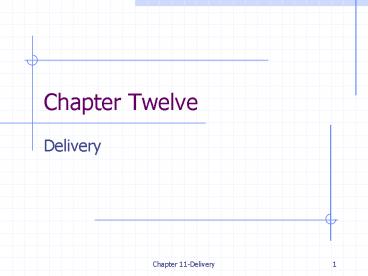Chapter Twelve - PowerPoint PPT Presentation
1 / 17
Title:
Chapter Twelve
Description:
Certain speeches must be delivered word for word, according to a meticulously ... As you gain more poise and confidence, however, you will discover how useful the ... – PowerPoint PPT presentation
Number of Views:36
Avg rating:3.0/5.0
Title: Chapter Twelve
1
Chapter Twelve
- Delivery
2
Methods of Delivery
- Reading from a Manuscript
- Reciting from Memory
- Speaking Impromptu
- Speaking Extemporaneously
3
Reading from a Manuscript
- Manuscript speech- a speech that is written out
word for word and read to the audience. - Certain speeches must be delivered word for word,
according to a meticulously prepared manuscript. - Ex. Popes religious proclamation, or a
Presidents message to Congress. - Misstated phrase could cause and international
incident.
4
Reading from a Manuscript
- Timing may also be a factor in manuscript
speeches. - If a political candidate purchases one minute of
media time, it needs to be stated and timed
perfectly. - Although it looks easy, delivering a speech from
a manuscript requires great skill. If not
practiced perfectly it will come across a reading
to their listeners, rather than talking with them.
5
Reciting from Memory
- It is no longer customary to memorize any but the
shortest of speeches- toasts, congratulatory
remarks, acceptance speeches, introductions, and
the like. - Objective be sure to memorize your speech
thoroughly that you will be able to concentrate
on communicating with the audience, not on trying
to remember the words.
6
Speaking Impromptu
- Impromptu speech- a speech delivered with little
or no immediate preparation. - If you keep your cool, organize your thoughts,
and limit yourself to a few remarks, your should
do fine.
7
Speaking Extemporaneously
- Extemporaneous speech- a carefully prepared and
rehearsed speech that is presented from a brief
set of notes. - Extemporaneous speech is carefully prepared and
practiced in advance. - Conversational quality means that no matter how
many times a speech has been rehearsed, it still
sounds spontaneous to the audience.
8
The Speakers Voice
- Volume
- Pitch
- Rate
- Pauses
- Vocal Variety
- Pronunciation
- Articulation
9
Volume
- Volume- the loudness or softness of the speakers
voice. - Be sure to adjust your voice to the accoutstics
of the room, the size of the audience, and the
level of background noise. - If you speak too loudly, your listeners will
think you are boorish. - If you speak too softly, they will not understand
you. Remember that your own voice always sounds
louder to you than to a listener.
10
Pitch
- Pitch- the highness of lowness of the speakers
voice. - Pitch is what makes the difference between the
Aha! triumphantly exclaimed by Sherlock Holmes
upon discovering a seemingly decisive clue and
the Aha he mutter when he learns the clue is
not decisive after all. - Changes in pitch are known as inflections.
- It is the inflection of your voice that reveals
whether you are asking a question or making a
statement whether you are being sincere or
sarcastic. - Repetitious patterns may be very hypnotic?
11
Rate
- Rate- the speed of which a person speaks.
- A fast rate helps to create feelings of
happiness, fear, anger, and surprise, while a
slow rate is better for expressing sadness or
disgust. - Understanding of the content of information?
- Research suggests that in most situations
listeners will find a speaker with a somewhat
faster rate than normal to be more competent and
more persuasive than a speaker with a slower rate.
12
Pauses
- As you gain more poise and confidence, however,
you will discover how useful the pause can be. It
can signal the end of a thought unit, give an
idea time to sink in, and lend dramatic impact to
a statement. - The right word may be effective, said Mark
Twain, but no word was ever as effective as
rightly timed pause. - Do not fill the silence with uh, er, or um.
These vocalized pauses, as they are called, are
always annoying and they can be devastating.
13
Pronunciation/Articulation
- Pronunciation- the accepted standard of sound and
rhythm for words in a given language. - See table on p. 300
- Articulation- the physical production of
particular speech sounds. - We habitually chop, slur, and mumble our words,
rather than enunciating them plainly. - See table on p. 301
14
Nonverbal Communication
- Nonverbal communication- communication that
occurs as a result of appearance, posture,
gesture, eye contact, facial expressions, and
other nonlinguistic factors. - Personal Appearance
- Bodily Action
- Gestures
- Eye Contact
15
Personal Appearance
- A number of studies have confirmed that personal
appearance plays an important role in
speechmaking. - Listeners always see you before they hear you.
- Appropriateness (Time and Place)
16
Gestures
- Gestures- motions of a speakers hands or arms
during a speech. - The primary rule is this Whatever gestures you
make should not draw attention to themselves and
distract from your messages. They should appear
natural and spontaneous, help to clarify or
reinforce your ideas, and be suited to the
audience and occasion. - Avoid flailing them about, wringing them
together, cracking your knuckles, or toying with
your rings. - Think about communicating with your listeners,
and your gestures will probably take care of
themselves- just as they do in conversation.
17
Eye Contact
- Eye contact- direct visual contact with the eyes
of another person. - In most circumstances, one of the quickest ways
to establish a communicative bond with your
listeners is to look at them personally and
pleasantly. - How you look at your audience counts. A blank
stare or a fierce hostile glare is almost as bad
as no eye contact at all. - Beware of the tenancy to gaze intently at one
part of the audience while ignoring the rest.































